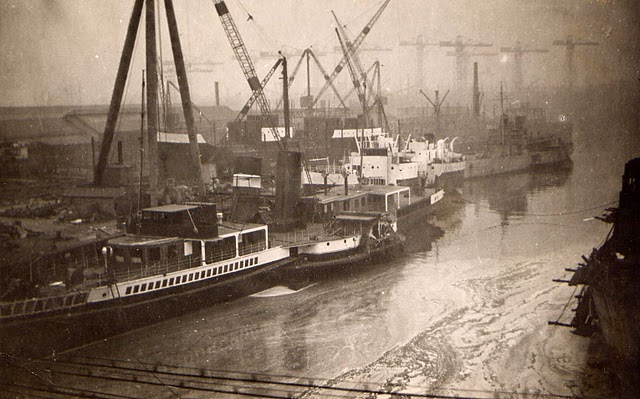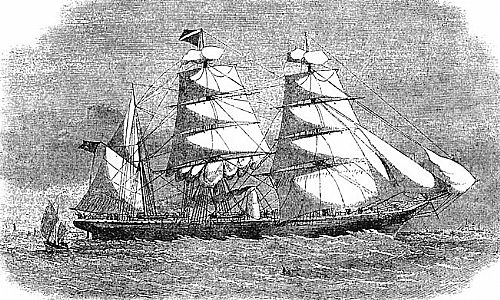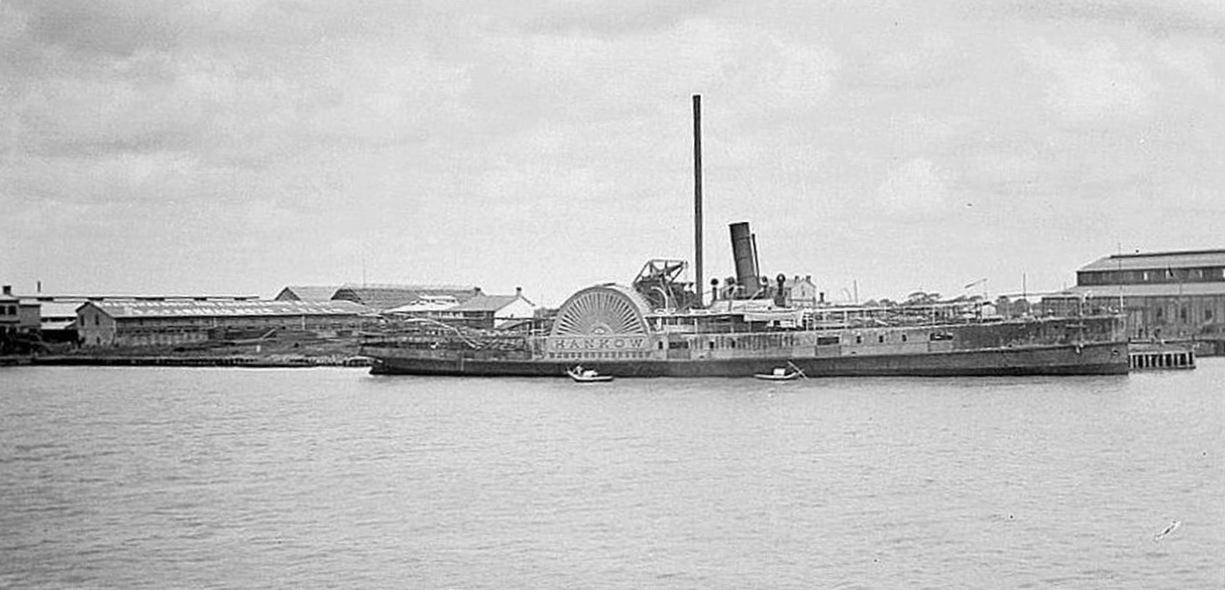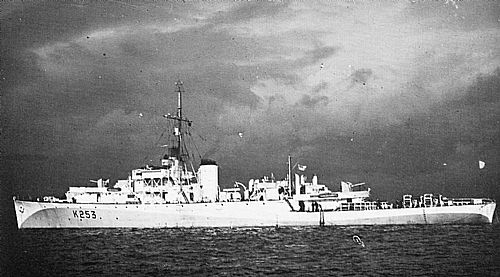A And J Inglis on:
[Wikipedia]
[Google]
[Amazon]
 A & J Inglis, Ltd, was a
A & J Inglis, Ltd, was a
 A & J Inglis of Glasgow was formed in 1848 as an engineering works. Thomas B. Seath founded the shipyard at Pointhouse in 1845 and it was acquired by A & J Inglis in 1862. In 1884 Anthony Inglis died and his son John Inglis took over. John Inglis himself, was well known for many maritime activities. In 1885 they launched 11 ships with a total tonnage of 7,470 tons.
In 1867, a ''Patent Slip Dock'' for ship repairs was built at Pointhouse. This was an innovative alternative to a dry dock, invented by Robert Napier. The vessel sat on a big trolley, which was on rails, and was hauled up onto dry land by a powerful winch. The yard had up to 2,000 employees on just 18 acres of ground plus approximately 300 workers at the former premises of the company in Whitehall Foundry.
In 1897, the Transatlantic Company of Paris ordered two of a total of ten fast mail steamers for their African service at A & J Inglis. Inglis delivered two weeks ahead of their competitors. The French owners were impressed and checked carefully that the fast-track build programme had not resulted in an inferior quality, but found no evidence of this, on the contrary they were delighted with the high standard of construction achieved.
A & J Inglis of Glasgow was formed in 1848 as an engineering works. Thomas B. Seath founded the shipyard at Pointhouse in 1845 and it was acquired by A & J Inglis in 1862. In 1884 Anthony Inglis died and his son John Inglis took over. John Inglis himself, was well known for many maritime activities. In 1885 they launched 11 ships with a total tonnage of 7,470 tons.
In 1867, a ''Patent Slip Dock'' for ship repairs was built at Pointhouse. This was an innovative alternative to a dry dock, invented by Robert Napier. The vessel sat on a big trolley, which was on rails, and was hauled up onto dry land by a powerful winch. The yard had up to 2,000 employees on just 18 acres of ground plus approximately 300 workers at the former premises of the company in Whitehall Foundry.
In 1897, the Transatlantic Company of Paris ordered two of a total of ten fast mail steamers for their African service at A & J Inglis. Inglis delivered two weeks ahead of their competitors. The French owners were impressed and checked carefully that the fast-track build programme had not resulted in an inferior quality, but found no evidence of this, on the contrary they were delighted with the high standard of construction achieved.
 Some of the first ships built by the shipyard were propelled by a combination of sails and steam engines. Because of their elegant design and high speed they were recognised as leading-edge representatives of their class.
The shipyard became famous by building the British
Some of the first ships built by the shipyard were propelled by a combination of sails and steam engines. Because of their elegant design and high speed they were recognised as leading-edge representatives of their class.
The shipyard became famous by building the British

 Famous ships built by the firm include the paddle steamer , now the world's last seagoing paddle steamer. Other Inglis-built paddle steamers include the , which still serves as a visitor attraction on
Famous ships built by the firm include the paddle steamer , now the world's last seagoing paddle steamer. Other Inglis-built paddle steamers include the , which still serves as a visitor attraction on
 During the Second World War the shipyard diversified into the built of military ships:
* laid down 13 October 1939, launched 23 May 1940 and completed 17 August 1940. Transferred to
During the Second World War the shipyard diversified into the built of military ships:
* laid down 13 October 1939, launched 23 May 1940 and completed 17 August 1940. Transferred to
South American and Australian paddle steamers built by A & J InglisPaddleducks
with high-resolution photographs of the ship yard.
A & J Inglis of Pointhouse : Shipbuilders and Engineers
{{DEFAULTSORT:A. and J. Inglis Defunct shipbuilding companies of Scotland 1862 establishments in Scotland 1962 disestablishments in Scotland Partick Companies based in Glasgow River Clyde British companies established in 1862 British companies disestablished in 1962
 A & J Inglis, Ltd, was a
A & J Inglis, Ltd, was a shipbuilding
Shipbuilding is the construction of ships and other floating vessels. It normally takes place in a specialized facility known as a shipyard. Shipbuilders, also called shipwrights, follow a specialized occupation that traces its roots to befor ...
firm founded by Anthony Inglis and his brother John, engineer
Engineers, as practitioners of engineering, are professionals who invent, design, analyze, build and test machines, complex systems, structures, gadgets and materials to fulfill functional objectives and requirements while considering the l ...
s and shipbuilders in Glasgow
Glasgow ( ; sco, Glesca or ; gd, Glaschu ) is the most populous city in Scotland and the fourth-most populous city in the United Kingdom, as well as being the 27th largest city by population in Europe. In 2020, it had an estimated popul ...
, Scotland
Scotland (, ) is a country that is part of the United Kingdom. Covering the northern third of the island of Great Britain, mainland Scotland has a border with England to the southeast and is otherwise surrounded by the Atlantic Ocean to the ...
in 1862. The firm built over 500 ships in a period of just over 100 years. Their Pointhouse Shipyard was at the confluence of the rivers Clyde Clyde may refer to:
People
* Clyde (given name)
* Clyde (surname)
Places
For townships see also Clyde Township
Australia
* Clyde, New South Wales
* Clyde, Victoria
* Clyde River, New South Wales
Canada
* Clyde, Alberta
* Clyde, Ontario, a tow ...
and Kelvin
The kelvin, symbol K, is the primary unit of temperature in the International System of Units (SI), used alongside its prefixed forms and the degree Celsius. It is named after the Belfast-born and University of Glasgow-based engineer and phys ...
. They constructed a wide range of ships, including Clyde steamer
The Clyde steamer is the collective term for several passenger services that existed on the River Clyde in Scotland, running from Glasgow downstream to Rothesay and other towns, a journey known as going ''doon the watter''.
The era of the Cly ...
s, paddle steamer
A paddle steamer is a steamship or steamboat powered by a steam engine that drives paddle wheels to propel the craft through the water. In antiquity, paddle wheelers followed the development of poles, oars and sails, where the first uses wer ...
s and small ocean liner
An ocean liner is a passenger ship primarily used as a form of transportation across seas or oceans. Ocean liners may also carry cargo or mail, and may sometimes be used for other purposes (such as for pleasure cruises or as hospital ships).
Ca ...
s. In wartime, they built small warship
A warship or combatant ship is a naval ship that is built and primarily intended for naval warfare. Usually they belong to the armed forces of a state. As well as being armed, warships are designed to withstand damage and are usually faster a ...
s, and in the period after World War II
World War II or the Second World War, often abbreviated as WWII or WW2, was a world war that lasted from 1939 to 1945. It involved the vast majority of the world's countries—including all of the great powers—forming two opposin ...
, they built a number of whaler
A whaler or whaling ship is a specialized vessel, designed or adapted for whaling: the catching or processing of whales.
Terminology
The term ''whaler'' is mostly historic. A handful of nations continue with industrial whaling, and one, Japa ...
s.
History
 A & J Inglis of Glasgow was formed in 1848 as an engineering works. Thomas B. Seath founded the shipyard at Pointhouse in 1845 and it was acquired by A & J Inglis in 1862. In 1884 Anthony Inglis died and his son John Inglis took over. John Inglis himself, was well known for many maritime activities. In 1885 they launched 11 ships with a total tonnage of 7,470 tons.
In 1867, a ''Patent Slip Dock'' for ship repairs was built at Pointhouse. This was an innovative alternative to a dry dock, invented by Robert Napier. The vessel sat on a big trolley, which was on rails, and was hauled up onto dry land by a powerful winch. The yard had up to 2,000 employees on just 18 acres of ground plus approximately 300 workers at the former premises of the company in Whitehall Foundry.
In 1897, the Transatlantic Company of Paris ordered two of a total of ten fast mail steamers for their African service at A & J Inglis. Inglis delivered two weeks ahead of their competitors. The French owners were impressed and checked carefully that the fast-track build programme had not resulted in an inferior quality, but found no evidence of this, on the contrary they were delighted with the high standard of construction achieved.
A & J Inglis of Glasgow was formed in 1848 as an engineering works. Thomas B. Seath founded the shipyard at Pointhouse in 1845 and it was acquired by A & J Inglis in 1862. In 1884 Anthony Inglis died and his son John Inglis took over. John Inglis himself, was well known for many maritime activities. In 1885 they launched 11 ships with a total tonnage of 7,470 tons.
In 1867, a ''Patent Slip Dock'' for ship repairs was built at Pointhouse. This was an innovative alternative to a dry dock, invented by Robert Napier. The vessel sat on a big trolley, which was on rails, and was hauled up onto dry land by a powerful winch. The yard had up to 2,000 employees on just 18 acres of ground plus approximately 300 workers at the former premises of the company in Whitehall Foundry.
In 1897, the Transatlantic Company of Paris ordered two of a total of ten fast mail steamers for their African service at A & J Inglis. Inglis delivered two weeks ahead of their competitors. The French owners were impressed and checked carefully that the fast-track build programme had not resulted in an inferior quality, but found no evidence of this, on the contrary they were delighted with the high standard of construction achieved.
Harland and Wolff
Harland & Wolff is a British shipbuilding company based in Belfast, Northern Ireland. It specialises in ship repair, shipbuilding and offshore construction. Harland & Wolff is famous for having built the majority of the ocean liners for the W ...
bought controlling shares in the company in 1919 but the yard remained independent. After Harland and Wolff, who also owned a larger yard on the opposite bank of the river at Govan
Govan ( ; Cumbric?: ''Gwovan'?''; Scots: ''Gouan''; Scottish Gaelic: ''Baile a' Ghobhainn'') is a district, parish, and former burgh now part of south-west City of Glasgow, Scotland. It is situated west of Glasgow city centre, on the south ba ...
, opted to consolidate its operations in Belfast
Belfast ( , ; from ga, Béal Feirste , meaning 'mouth of the sand-bank ford') is the capital and largest city of Northern Ireland, standing on the banks of the River Lagan on the east coast. It is the 12th-largest city in the United Kingdo ...
, the yard closed in 1962 and is now the site of the new Riverside Museum
The Riverside Museum (formerly known as the Glasgow Museum of Transport) is a museum in Glasgow, housed in a building at Pointhouse Quay in the Glasgow Harbour regeneration district of Glasgow, Scotland. The building opened in June 2011, winnin ...
.
Ships
Clippers and yachts
 Some of the first ships built by the shipyard were propelled by a combination of sails and steam engines. Because of their elegant design and high speed they were recognised as leading-edge representatives of their class.
The shipyard became famous by building the British
Some of the first ships built by the shipyard were propelled by a combination of sails and steam engines. Because of their elegant design and high speed they were recognised as leading-edge representatives of their class.
The shipyard became famous by building the British Royal Yacht
A royal yacht is a ship used by a monarch or a royal family. If the monarch is an emperor the proper term is imperial yacht. Most of them are financed by the government of the country of which the monarch is head. The royal yacht is most often c ...
and the Egyptian Royal Yacht . The turbine yacht was built of steel, rigged as a triple screw schooner and, unusually, was powered by steam turbines.
Paddle steamers

 Famous ships built by the firm include the paddle steamer , now the world's last seagoing paddle steamer. Other Inglis-built paddle steamers include the , which still serves as a visitor attraction on
Famous ships built by the firm include the paddle steamer , now the world's last seagoing paddle steamer. Other Inglis-built paddle steamers include the , which still serves as a visitor attraction on Loch Lomond
Loch Lomond (; gd, Loch Laomainn - 'Lake of the Elms'Richens, R. J. (1984) ''Elm'', Cambridge University Press.) is a freshwater Scottish loch which crosses the Highland Boundary Fault, often considered the boundary between the lowlands of Ce ...
, and the forerunner to the Humber Bridge, which was controversially broken up in situ at Grimsby's Alexandra Dock, despite her uniqueness of design as what was likely to have been Inglis's only cargo carrying estuary paddle steamer; designed chiefly as a practical workhorse as opposed to a more elegant 'pleasure steamer' image more commonly associated with paddle steamers. In ocean-going service, paddle steamers became much less useful after the invention of the screw propeller, but they remained in use in coastal service and as river tugboats, thanks to their shallow draught and good manoeuvrability.
Conversions and extensions
The shipyard was also specialised in conversions: On 16 May 1901 the TS ''King Edward'' was launched, which had been built byWilliam Denny and Brothers
William Denny and Brothers Limited, often referred to simply as Denny, was a Scottish shipbuilding company.
History
The shipbuilding interests of the Denny family date back to William Denny (born 1779), for whom ships are recorded being built ...
in Dumbarton
Dumbarton (; also sco, Dumbairton; ) is a town in West Dunbartonshire, Scotland, on the north bank of the River Clyde where the River Leven flows into the Clyde estuary. In 2006, it had an estimated population of 19,990.
Dumbarton was the ca ...
. The builders hoped to attain a speed of with the turbine machinery. However, on 24 June 1901 in seven return runs over the mile, the best mean speed attained was . On the next day at the Pointhouse yard of A. & J. Inglis the central propeller of diameter was exchanged for one of diameter, and the outer propellers of diameter were exchanged for propellers diameter. Trials on 26 June 1901 achieved a mean of .
In 1905, an extension and rebuild of the SS ''Mahroussa'' was undertaken. The ship had been originally built for Isma'il Pasha
Isma'il Pasha ( ar, إسماعيل باشا ; 12 January 1830 – 2 March 1895), was the Khedive of Egypt and conqueror of Sudan from 1863 to 1879, when he was removed at the behest of Great Britain. Sharing the ambitious outlook of his gran ...
, the Khedive of Egypt and was later renamed to SS '' El Horria''. The two paddle wheels were replaced by triple screws powered by steam turbines built by Inglis at their Warroch Street Engine Works in Glasgow. Inglis were one of the first companies licensed by the Parsons Marine Steam Turbine Company Wallsend for the manufacture of steam turbines in their own works. The ship was still in use in 2001 as a luxury yacht.
Railway ferries
Inglis built eight ferries between 1907 and 1929 for the Entre Rios Railways Co. in Argentina. These were used between 1907 and 1990 to cross theParaná River
The Paraná River ( es, Río Paraná, links=no , pt, Rio Paraná, gn, Ysyry Parana) is a river in south-central South America, running through Brazil, Paraguay, and Argentina for some ."Parana River". Encyclopædia Britannica. Encyclopædia Br ...
and join the Buenos Aires province and the Entre Rios province, until new bridges were built over the rivers they crossed:
* ''Lucía Carbó'' (1907)
* ''María Parera'' (1908)
* ''Mercedes Lacroze'' (1909)
* ''Roque Saenz Peña'' (1911)
* ''Exequiel Ramos Mejía'' (1913)
* ''Dolores de Urquiza'' (1926)
* ''Delfina Mitre'' (1928)
* ''Carmen Avellaneda'' (1929)
Pictures of the Argentine train ferries at the Histarmar website.
Motor vessels
The was originally christened ''Lady Sylvia'' when launched in 1937 for the use onBarkley Sound
, image = Fishing boat in the Broken Group Islands.jpg
, image_size = 260px
, alt =
, caption = Barkley Sound
, image_bathymetry =
, alt_bathymetry =
, caption_bathymetry =
, locat ...
. She was designed for the sheltered coastal waters of British Columbia. However, this was the first diesel powered vessel to cross the Atlantic driven by a single propeller. ''Lady Rose'' was acquired by the Clayton family of Sechelt in September 2019 and she was relocated to the MacKenzie Marina in Sechelt soon thereafter. Restoration plans are still being formulated.
and were coastal tankers built in 1945 for the Ministry of War Transport
The Ministry of War Transport (MoWT) was a department of the British Government formed early in the Second World War to control transportation policy and resources. It was formed by merging the Ministry of Shipping and the Ministry of Transport ...
(MoWT).
Lightships
The ''North Carr'' Lightship was launched in 1932 and created quite a stir inEdinburgh
Edinburgh ( ; gd, Dùn Èideann ) is the capital city of Scotland and one of its 32 Council areas of Scotland, council areas. Historically part of the county of Midlothian (interchangeably Edinburghshire before 1921), it is located in Lothian ...
on account of her fog horn being tested while lying ¾ mile off Granton, Edinburgh
Granton is a district in the north of Edinburgh, Scotland. Granton forms part of Edinburgh's waterfront along the Firth of Forth and is, historically, an industrial area having a large harbour. Granton is part of Edinburgh's large scale waterf ...
in the Firth of Forth
The Firth of Forth () is the estuary, or firth, of several Scottish rivers including the River Forth. It meets the North Sea with Fife on the north coast and Lothian on the south.
Name
''Firth'' is a cognate of ''fjord'', a Norse word meani ...
. As the fog horn had a range of approximately 10 miles, north Edinburgh could hear it loud and clear and the complaints were numerous - particularly as it was being sounded in clear weather. "Hundreds of city dwellers have had no sleep over three consecutive nights" and "The most flagrant individual breach of the peace is as nothing compared with the ceaseless boom and consequent suffering of the past three nights" were typical statements at the time.
Selection of military ships
 During the Second World War the shipyard diversified into the built of military ships:
* laid down 13 October 1939, launched 23 May 1940 and completed 17 August 1940. Transferred to
During the Second World War the shipyard diversified into the built of military ships:
* laid down 13 October 1939, launched 23 May 1940 and completed 17 August 1940. Transferred to Greece
Greece,, or , romanized: ', officially the Hellenic Republic, is a country in Southeast Europe. It is situated on the southern tip of the Balkans, and is located at the crossroads of Europe, Asia, and Africa. Greece shares land borders with ...
as ''Kriezis''.
* laid down 26 October 1939, launched 26 June 1940 and completed 20 October 1940.
* and – s - Both launched 1940, sold 1946
* – naval trawler
Naval trawlers are vessels built along the lines of a fishing trawler but fitted out for naval purposes; they were widely used during the First and Second World Wars. Some—known in the Royal Navy as "Admiralty trawlers"— were purpose-built to ...
– Launched 1941, sold 1946
* – Shakespearian-class naval trawler – Launched 3 May 1941, transferred to Kenya 1946, joined Royal East African Navy
The Royal East African Navy was a unified naval force of the former British colonies of Kenya, Tanganyika, Uganda, and Zanzibar. It was the colonial forerunner of the Kenyan Navy and Tanzanian Navy.Gray, Randal, ed., ''Conway's All the World's F ...
1952, redeployed to Madagascar 1964
* was a that was launched on 28 September 1943 and served in the Royal Canadian Navy.
* , and – naval trawlers - Launched 1942-43
* – – Launched 10 December 1944, Became OWS ''Weather Reporter'' in 1957.
* – originally ''Totnes Castle'' – Castle-class corvette – Launched 12 April 1944. Transferred to Canada as HMCS ''Humberstone'' 1944. Sold for mercantile service 1947
* was an Empire
An empire is a "political unit" made up of several territories and peoples, "usually created by conquest, and divided between a dominant center and subordinate peripheries". The center of the empire (sometimes referred to as the metropole) ex ...
coaster. Launched on 19 January 1945 and completed in April 1945. Sold in 1948 to Kuwait Oil Company and renamed ''Adib''. Operated under the management of Angli-Iranian Oil Co Ltd. Sold in 1952 to Shell-Mex and BP
Shell-Mex and BP Ltd was a British joint venture between petroleum companies Royal Dutch Shell (Shell) and BP. It was formed in 1932 when both companies decided to merge their United Kingdom marketing operations,Reference and contact details: GB ...
Ltd and renamed ''BP Transporter''. Scrapped in June 1965 in Antwerp, Belgium.
Cancelled military orders
Several military orders for corvettes and tankers were cancelled at the end of the Second World War: * ''Dover Castle'' and ''Dudley Castle'' - ''Castle'' class corvettes - ordered 19 January 1943. * ''Empire Tedellen'' was to have been an coastal tanker but the contract for building her was cancelled. TheEmpire ships
An Empire ship is a merchant ship that was given a name beginning with "Empire" in the service of the Government of the United Kingdom during and after World War II. Most were used by the Ministry of War Transport (MoWT), which owned them and co ...
were a series of ships in the service of the British Government. Their names were all prefixed with "Empire". Mostly they were used during World War II
World War II or the Second World War, often abbreviated as WWII or WW2, was a world war that lasted from 1939 to 1945. It involved the vast majority of the world's countries—including all of the great powers—forming two opposin ...
by the Ministry of War Transport
The Ministry of War Transport (MoWT) was a department of the British Government formed early in the Second World War to control transportation policy and resources. It was formed by merging the Ministry of Shipping and the Ministry of Transport ...
(MoWT), who owned the ships but contracted out their management to various shipping lines.
References
External links
South American and Australian paddle steamers built by A & J Inglis
with high-resolution photographs of the ship yard.
A & J Inglis of Pointhouse : Shipbuilders and Engineers
{{DEFAULTSORT:A. and J. Inglis Defunct shipbuilding companies of Scotland 1862 establishments in Scotland 1962 disestablishments in Scotland Partick Companies based in Glasgow River Clyde British companies established in 1862 British companies disestablished in 1962